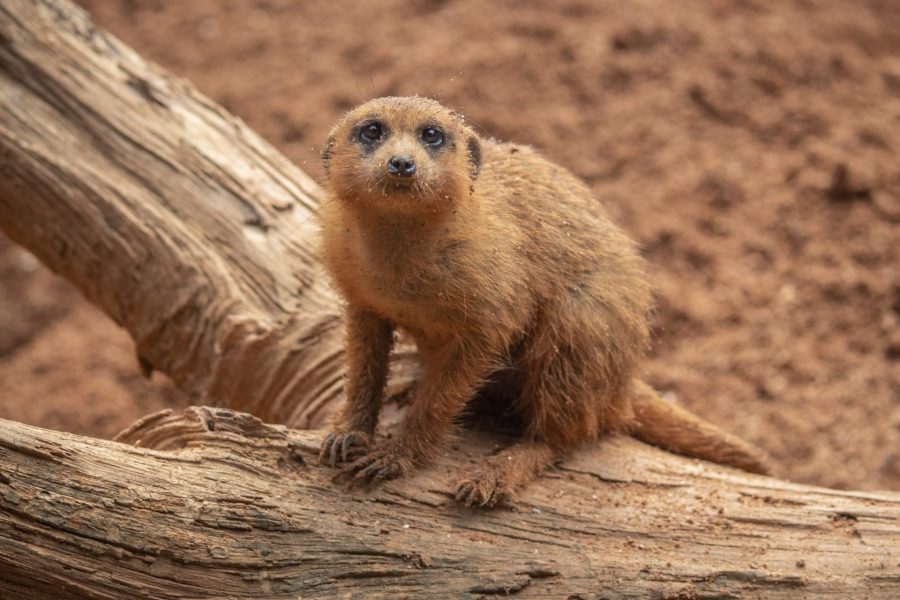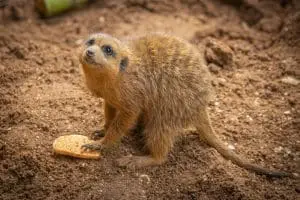

Kirabo will be missed for our Expedition Africa keepers and volunteers.
We’re sorry to share that we recently made the compassionate and difficult decision to euthanize our dominant male meerkat, Kirabo. He was 10 years old, around the median lifespan for this species.
Our animal care team started noticing that Kirabo was showing signs of lameness and difficulty with balance in August – along with a decreased interest in food. These problems were infrequent at first but recently progressed into a constant issue. Earlier this month, we brought Kirabo to Rockledge Regional Medical Center for an MRI.
The MRI found that Kirabo had degenerative intervertebral disc disease (IVDD) at one place in his neck and several places in the thorax and abdomen sections of his vertebral column. This disease causes the discs of connective tissue between the vertebral bones to bulge upward so that it compresses into the spinal cord. This caused Kirabo’s difficulty with mobility.
Unfortunately, IVDD is hard to treat and has a poor prognosis, especially in an animal of Kirabo’s age and size. He was treated with antibiotics, an anti-inflammatory and an appetite stimulant.
All animal residents at our Zoo experiencing health issues are given regular quality of life assessments. An animal care team looks at objective measures like the resident’s hygiene, mobility, appetite, and more, to prevent future suffering. When Kirabo’s quality of life deteriorated, the decision was made that euthanasia would be the most compassionate choice for him.
“He was a very special little guy, and he will be greatly missed,” said one of Kirabo’s keepers, Alyssa Simon.
 Kirabo first came to our Zoo in 2013. His name is from African descent that means “Gift from God.” Although he was our dominant male meerkat, Kirabo was actually our smallest meerkat. His distinguished appearance made him a favorite among keepers and volunteers.
Kirabo first came to our Zoo in 2013. His name is from African descent that means “Gift from God.” Although he was our dominant male meerkat, Kirabo was actually our smallest meerkat. His distinguished appearance made him a favorite among keepers and volunteers.
He was often heard barking during feedings – eager for snacks, especially superworms. Alyssa said she had an amazing time training him to voluntarily enter a secure carrier. He and his whole meerkat family know how to enter the carrier and close the door, which increases their comfort.
“He could often be seen on habitat foraging, digging, and resting in what keepers like to call a ‘cuddle puddle’ with his family,” Alyssa said.
Kirabo sired more than 20 meerkats with his partner, Cashew, who remains at our Zoo. While many of his offspring have moved to other zoos, his offspring Pistachio, Almond, Toffee, Hazelnut, Peanut, Macadamia, Cupid, Vixen and Stella still call our Zoo home at this time.
In July, we shared that some changes would be coming to our meerkat mob as we prepared to allow Kirabo and Cashew to breed again. For now, Cashew has been given a birth control implant. We will still be saying goodbye to several males in our mob as we send them to facilities accredited by the Association of Zoos and Aquariums, but with the intention of starting a new breeding group now.
Our Zoo participates in the Species Survival Plans (SSP) for meerkats. SSPs ensure that there are healthy, genetically diverse animals in AZA-accredited zoos. This means that animals may need to move to other zoos to potentially pair with genetically compatible mates – or make room for residents at their original zoo to do so.
We’ll keep you updated on how our mob changes in the coming months. For now, you should see most of our mob in their home at Expedition Africa.
